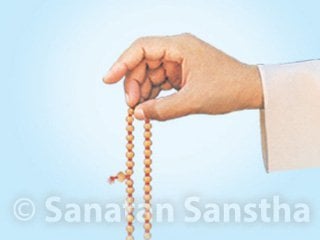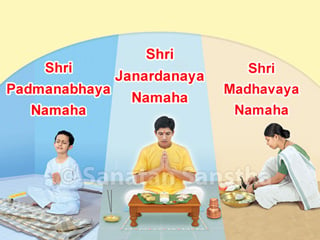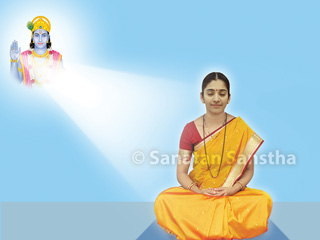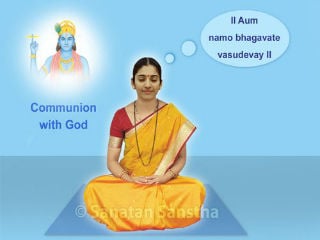Contents
- 1. Purification of the mantra
- 2. Utkilan (nishkilan)
- 3. Befriending mantras (mantramaitri)
- 4. Emancipation from the curse (shapvimochan)
- 5. Sanskars (rites) on the mantras
- 6. Activation of mantras
- 7. A Purashcharan
- 8. Meaning of the mantra
- 9. Comparative importance of the techniques
- 10. ‘The six tantrik acts (shatkarmas) essential for proving a mantra (mantrasiddhi)
- 11. The efficacious (siddha) mantras
1. Purification of the mantra
‘Before any mantra is made efficacious (siddha) it has to be purified. The seven methods of purifying a mantra are given in Goutamiya as follows –
भ्रामणं रोधनं वश्यं पीडनं शोषपोषणे ।
दहनान्तं क्रमात् कुर्यात् तत: सिद्धिर्भवेन्न तु ।In brief it means :
| 1. Bhraman (भ्रामण) |
: Interweaving of all the consonants of the mantra with ‘yam’ the bija of the vayu (absolute air) element. |
| 2. Rodhan (रोधन) |
: Chanting of the mantra should be done with the bija Om. |
| 3. Vashikaran (वशीकरण) |
: Using a paste of either alata, redsandalwood (raktachandan), turmeric, thorn apple (dhatura) seeds or red arsenic sulphate, the mantra should be written on a parchment of birch bark (bhurja patra). |
| 4. Pidan (पीडन) |
: The mantra should be written with the latex of a special type of gum tree and should be pressed with the foot. |
| 5. Shoshan (शोषण) |
: The mantra should be chanted after the addition of the bija ‘vam’ of Varun. |
| 6. Poshan (पोषण) |
: The mantra should be chanted after the addition of the three bijamantras prescribed by the Guru. Then it should be written using cow’s milk or honey. |
| 7. Dahan (दहन) |
: The mantra should be chanted with the insertion of ‘ram’ the bija of Agni in the beginning, middle and at the end of the mantra. Then it should be written with oil extracted from the seeds of the palash tree.’ (1) |
2. Utkilan (nishkilan)
Some mantras are impure. Once they are activated with bijakshars their cleansing occurs and their energy becomes manifest.
3. Befriending mantras (mantramaitri)
‘Often one has to befriend mantras. This friendship is achieved through rituals. Depending on the cause for which the mantra is required and to what extent that cause is pure, impure, mild, harsh, auspicious, inauspicious, complimentary or harmful, one has to perform some rites (kriya) on that mantra accordingly. The seats (asans), malas (rosaries) and yantras used while performing them vary. (There are also various types of mantras for befriending mantras).
4. Emancipation from the curse (shapvimochan)
Various sages have cursed some mantras. Lord Shankar has cursed seven crores of mahamantras. The Gayatri mantra too has been cursed by Sages Vasishtha and Vishvamitra, Lord Brahma and Varun.’(2) Hence, for a mantra to become efficacious the curse has to be eliminated in the following ways.
A. Under the guidance of one’s Guru the following mantras should be chanted consecutively,
- Gayatri mantra
- Mrutyunjay mantra
- ‘Jatvedase …’ (sukta) from the Vedas
- Gayatri mantra
- ‘Paro rajase savadom …’ (sukta) from the Vedas
- ‘Hansaha so’ham।
- Chanting the words in the mantra in a reverse order.
B. The ritual of sanjivan: All the tantrik procedures involved in this ritual have been described in detail in the science of Tantra.
5. Sanskars (rites) on the mantras
For any mantra to be effective one needs to perform the following ten sanskars on it under the guidance of a Guru.
- A. Janan: The mantra should be written on a parchment of birch bark (bhurjapatra) with a bright yellow pigment from the bile or urine or head of a cow (gorochan). Then a yantra of the mantra should be made as described in the scriptures and worshipped after invocation (avahan) of the deity of the mantra.
- B. Dipan: One should chant ‘hansaha – “mantra” – so.. ham’ one thousand times.
- C. Bodhan: One should chant ‘hansaha – “mantra” – hansaha’ five thousand times.
- D. Tadan: One should chant ‘phat – “mantra” – phat one thousand times.
- E. Abhishek (consecration by sprinkling water or liquids): ‘Aim hansaha Om – “mantra” – aim hansaha Om’ and chant the mantra one thousand times. While chanting the mantra one should continuously sprinkle water on the mantra written on a parchment of birch bark.
- F. Vimalikaran: One should chant ‘Om troum vashat “mantra”- vashat troum Om’ one thousand times.
- G. Jivan: One should chant ‘svadha vashat – “mantra”- vashat svadha’ one thousand times.
- H. Tarpan: One should sprinkle milk, ghee and water on the mantra written on a parchment of birch bark each time while chanting the mantra a thousand times.
- I. Gopan: One should chant ‘rhim – “mantra” – rhim’ one thousand times.
- J. Apyayan: One should chant ‘hansaha – “mantra” – so’.ham’ one thousand times.
6. Activation of mantras
The activation of a mantra means increasing the energy in it.
For the mantras of fire or the sun one should chant the mantra ‘Om ram’ when the Ida channel (nadi) is operational, that is, when breathing is occurring through the left nostril. The mantra should also be chanted for the mellow mantras or those of the moon when the Pingala channel is operational, that is, when breathing is occurring through the right nostril.
7. A Purashcharan
7.1 Definition
- A. According to Vayusanhita, ‘पुरत: चरणं’ means a purashcharan, that is, the worship of a deity performed with a tantra, mantra and chanting (japa) and the prescribed rituals done to enable the mantra to give the expected results, before commencing the chanting of the mantra.
- B. ‘मंत्रफलसिद्ध्यर्थं नियतसङ्ख्याको जप: ।’ means particular quantity of chanting for the acquisition of the desired result of the mantra [of the benevolent deity (ishtadevata)] is termed as a purashcharan or a puraskriya.
7.2 Importance
According to the text Yoginihruday, just as a lifeless person is unable to perform any action so also without a purashcharan, a mantra is incapable of imparting supernatural powers (siddhis). Although the mantra obtained from the Guru is efficacious yet in some sects its purashcharan is performed. With the ritual of purashcharan, the mantra becomes efficacious and the deities too are appeased.
7.3 Parts
Chanting (japa), sacrificial fire (hom), offering to the ancestors (tarpan), consecration of the deity by sprinkling water or liquids such as milk (abhishek / marjan) and offering food to Brahmans (Brahmanbhojan) constitute the five parts of a purashcharan.
7.4 Preparations
A purashcharan is commenced on an auspicious day, in the first half of the bright fortnight of the month, of the Hindu lunar when the moon and planets are favourable. It may also be performed at the time of an eclipse. During a solar eclipse the purashcharan gets completed only with the number of rounds done from the time of the commencement of the eclipse till its end. The rule mentioned later, of chanting the mantra a thousand times is not applicable to it. However, the eclipse should not be of the type where one merely sees its onset or the end. One may choose any half of the lunar month for the purashcharan according to one’s ability.
Holy places, river banks, caves, mountain peaks, confluence of rivers, isolated parks, temples of Lord Shiva, etc. are considered ideal to perform a purashcharan. A site where the cold, wind or rain will not affect the doer or cause physical ailments and also where the concentration will not be disturbed by anything should be chosen for the purashcharan. Prior to the commencement of the purashcharan of a mantra the seeker should perform the sanskars (rites) of Mukhashodhan, Jivhashodhan, Ashouchabhang, Kulluk, Nirvan, Setu, Nidrabhang and Mantrajagar and also austerities like Kruchchra, etc.
In order to purify the physical body one should partake of a mixture of milk, curd, butter, urine and dung of the cow (panchgavya) and should wear the sacred thread (yadnyopavit). In order to overcome any defects in the mantra one should chant the Gayatri mantra a thousand or ten thousand times, recite the Varunsuktas like Apohishtha, etc. Panchasukta, Pavamansukta, Rudrasukta and make offerings to the sages (rushitarpan) on the eve of the purashcharan. If one is unable to recite the Suktas then one should invite Brahman (priest) to recite them and should listen to them. One should observe a fast on the previous day.
7.5 The day of the purashcharan
One should perform Punyaha-vachan, Matrukapujan and Nandishraddha after expressing the resolve (sankalpa). A seat made of grass (darbhasan), deerskin or wool should be used for the purashcharan. The same seat and place should be chosen everyday. One should then perform the ritual of taking the seat (asanvidhi) with mantras like ‘pruthvi tvaya dhruta loka….’, etc. Then after performing nyas [establishing the benevolent deity (ishtadevata) or the mantra], praying to the deities, sprinkling holy water on the mala (prokshan) and meditating on the Savita (Sun) deity, chanting should be commenced.
A Japa
The total chanting of the purashcharan should be equivalent to the number of letters in the mantra, in lakhs or crores. It is necessary to complete a specific quantity of chanting everyday and to conclude it before noon.
If one decides to perform a purashcharan in thousands and if one performs hundred rounds (avartans) everyday then in a span of ten days one mini purashcharan will be completed. One should decide the number of rounds depending on one’s capacity. If the number is reduced then more days will be required to complete it and vice-versa. However one should remember that as far as possible one should complete the number of rounds decided in the beginning. Ancient texts like Mundamala, etc. clearly state that one should neither decrease or increase the quantity nor break the routine. However, Sage Vaishampayan states that if on account of difficulties like ill health, fever, impurities due to mourning or childbirth (soyar-sutak), etc. more time is taken or a variation in the predetermined quantity occurs, then it does not amount to sin.
Since Ganapatyatharvashirsha is the Upanishad Shrutiveda women cannot practise it. Ganapatyatharvashirshabhashya prescribes the purashcharan in multiples of thousand. However from the science of Mantra one can also select quantities such as ten thousand, etc. Accordingly three types of purashcharans are possible viz. primary with 1000, medium with 10,000 and superior with 1,00,000 rounds (avartans). For the fulfillment of one’s desires one can also perform purashcharans in the Mandal Mahamandal method of chanting, 441 (21 x 21) or 9261 (21 x 21 x 21) times.
B Havan
After completion of the predetermined quantity, a havan (offering an oblation with fire) is performed with one tenth of that quantity. If this is not possible then one should chant four times the quantity of the havan. During a Gayatri purashcharan an oblation of boiled rice (charu), sesame seeds, a sweet made of rice and milk (payas), durva and sacrificial fire sticks (samidha) is used in the havan. According to the Vishnudharmottar Puran, the ingredient used in the havan should be modified according to the resolve of the purashcharan.
| The desire | Ingredients used in the havan |
The desire | Ingredients used in the havan |
| Nullification of all sins |
Sesame seeds | Foodgrain | Uncleaned rice |
| Serenity | Barley | Pacifying the planets (Grahashanti) |
Sacrificial firewood (Samidha) |
| Longevity | Clarified butter (Sesame oil, cooked rice mixed with clarified butter) |
Wealth | Fruits of the bel tree |
| Success in rituals |
Mustard seeds | Opulence | Lotus |
| Divine spendour, Knowledge |
Milk (Payas) | Health | Durva and milk |
| A son | Curd | Marital happiness |
Globules of guggul |
C Tarpan
Tarpan of the benevolent deity (ishtadevata) is performed with another tenth of the quantity of the havan.
D Marjan (abhishek)
Consecration of the deity by sprinkling liquids is to be performed with a tenth quantity of the tarpan.
E Offering food to Brahmans (Brahmanbhojan)
One should offer food to Brahmans in a number equivalent to one tenth of the abhishek. If offering food to Brahmans is not possible then the Guru should be worshipped and appeased.
One can also perform a purashcharan consisting of one, two, three, four, five or ten or more parts.
F Alternatives to a havan
If a havan, etc. is not possible due to financial constraints then according to the mundamalatantra the purashcharan can be performed with chanting (japa) too. If one wishes to do 24,00,000 purashcharans of a mantra then one can perform chanting as follows as an alternative to a havan, etc.
| Quantity of chanting |
|
| 1. A purashcharan | 24,00,000 |
| 2. A havan after suffixing ‘svaha’ to the mantra |
2,40,000 |
| 3. Tarpan after suffixing ‘savitaram tarpayami’ |
24,000 |
| 4. Marjan after suffixing ‘atmanam marjayami’ |
2,400 |
| 5. Offering food to Brahman | 240 |
| Total | 26,66,640 |
G Rules and restrictions
The host performing the purashcharan has to follow certain rules and restrictions of diet. Eating food cooked by outsiders, a body massage, intercourse, telling lies, etc. are prohibited.
7.6 Conclusion (samapti)
After the completion of the purashcharan the host should offer money (dakshina) to the priest according to his financial capacity and should surrender the action unto God. Speaking falsely during the purashcharan and leaving the site of the purashcharan are forbidden. During the purashcharan period the host should sleep on the floor. One should not undertake a purashcharan during the four months of chatrumas.
Performing a purashcharan by oneself is more beneficial than getting it done through a Brahman.
(The above information is based on excerpts from volumes 2 and 5 of the Bharatiya Sanskrutikosh and Savidhanam Shriganapatyatharvashirsham, First edition 1981, pages 106-111, Publisher: Keshav Bhikaji Dhavale, Mumbai 400 004.)
8. Meaning of the mantra
One should chant the mantra concentrating on its meaning and thus let the whole body get engrossed in it.
9. Comparative importance of the techniques
| The Technique | The Importance |
| 1. Purification of the mantra | 4 |
| 2. Removal of the Kilak (utkilan) | 2 |
| 3. Befriending the mantra | 2 |
| 4. Emancipation from the curse | 2 |
| 5. Sanskars (rites) performed on the mantra |
5 |
| 6. Activation of the mantra | 5 |
| 7. Purashcharan | 70 |
| 8. Meaning of the mantra | 2 |
| 9. Others | 8 |
| Total | 100 |
Reference:
‘Path of Chanting The Lord’s Name (Namasankirtanyoga) and Path of Mantra (Mantrayoga)’, published by Sanatan Sanstha.
Bharatiya Sanskrutikosh. Publishers: Pandit Mahadevshastri Joshi, Secretary, Bharatiya Sanskrutikosh Mandal, 410 Shanivar Peth, Pune 411 030.
Vol. 1 and 2: Second edition Vol. 3 to 10: First edition
1. Vol. 6, Pg. 649 2. Vol. 6, Pg. 649
3. Vol. 9, Pg. 500 4. Vol. 6. Pg. 650

 Why do we chant Name of Kuladevi instead of Kuladev?
Why do we chant Name of Kuladevi instead of Kuladev? Guidance by His Holiness Bhagwantkumar Menrai on how to coordinate chanting the Name of God...
Guidance by His Holiness Bhagwantkumar Menrai on how to coordinate chanting the Name of God... How different chants can help avoid unfavourable incidents ?
How different chants can help avoid unfavourable incidents ? How chanting purifies the mind ?
How chanting purifies the mind ? How does chanting help us to achieve oneness with God?
How does chanting help us to achieve oneness with God? Spiritual benefits of chanting God’s Name
Spiritual benefits of chanting God’s Name